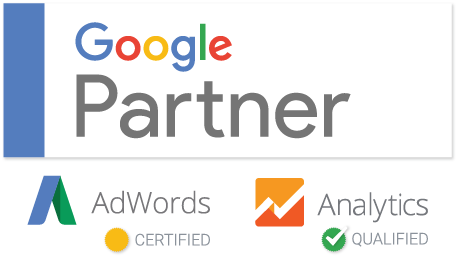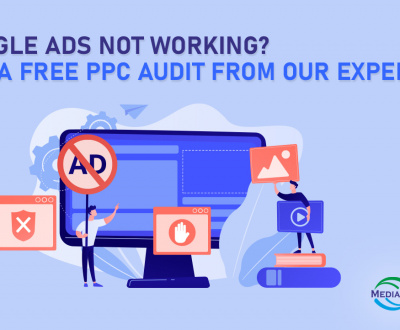Top 10 Google Ads Mistakes That Waste Your Budget (And How to Fix Them)
- August 11, 2025
- PPC ads
Running Google Ads is like shopping for targeted customers. You get what you opt for and pay for it. If you tick the right options, you get customers who convert and increase your profit. But if you tick the wrong boxes, you waste money on traffic that doesn’t convert. For this reason, every online marketer must understand Google Ads mistakes.
When we say every marketer, it includes seasoned Google Ads marketers. Even they can make mistakes, only to regret their decisions after facing losses. For example, over-relying on automation could prove to be a costly mistake. Similarly, ignoring performance data could drain the budget. Running Google Ads requires a balanced approach between the dos and don’ts of paid advertising.
Here are 10 common mistakes that even Google wants the ad managers to avoid. These technical errors, primarily related to ad settings, can create trouble. If you don’t want Google Ads to be missed opportunities, you should understand the mistakes and learn how to fix them.
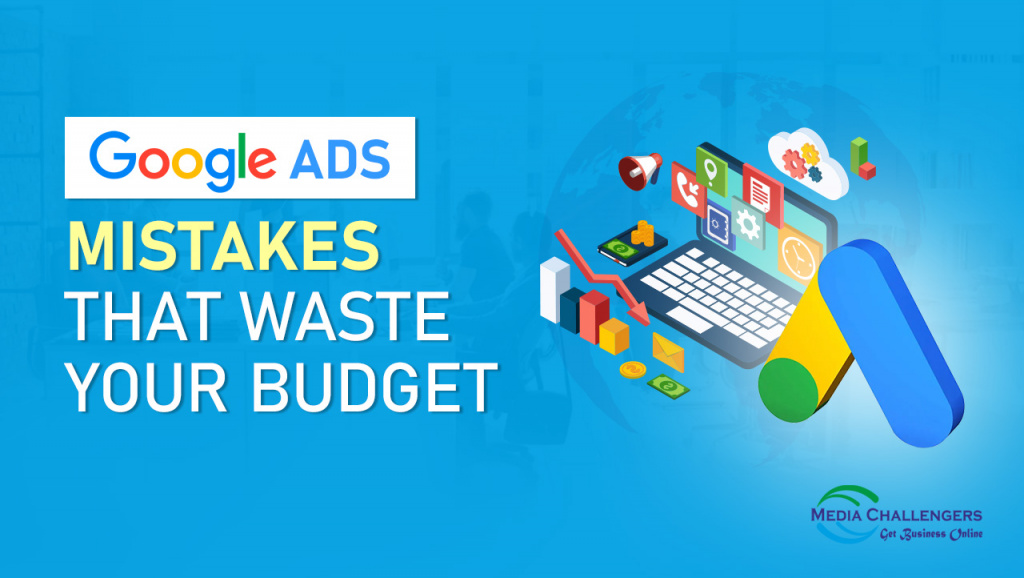
Top 10 Google Ads Mistakes
1. Using Wrong Keyword Match Types
Why it’s a problem: Broad match keyword types often invite random queries, wasting budget with low-intent clicks.
Red flags: A significant increase in the number of clicks, but no significant increase in conversions
Example: A “luxury leather handbag” website generating queries for “used leather bags for sale”.
Fix: Use a phrase and exact matches, and also use negative keywords to filter off-base queries.
Pro Tip: Regularly check the search term reports to exclude irrelevant queries.
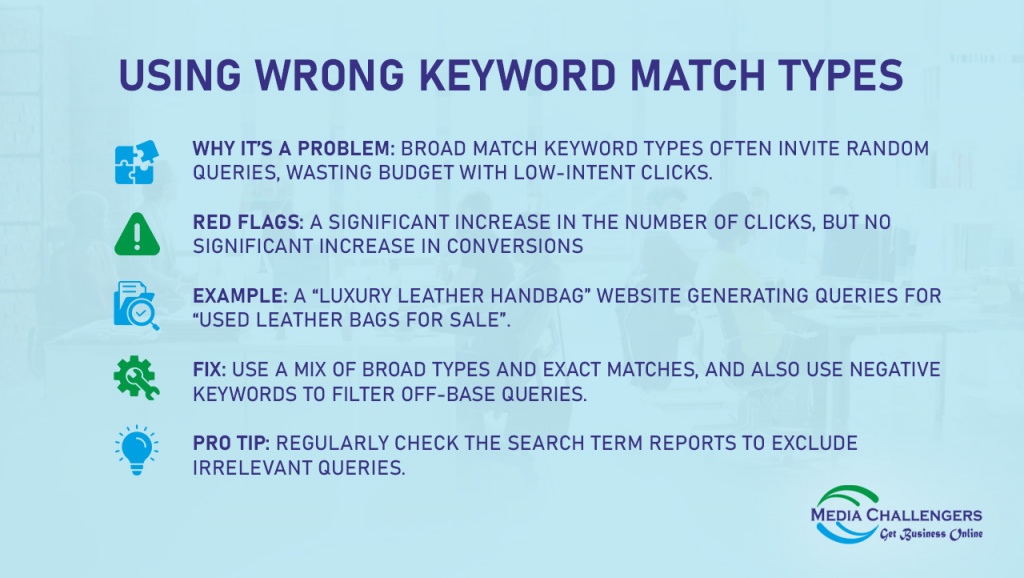
2. Poorly Written Ad Missing the Intent
Why it’s a problem: Viewers find the ad content boring, uninspiring, and confusing at first sight.
Red flags: The click-through rate (CTR) remains low despite high impressions due to poor ad writing.
Example: A premium men’s leather shoes website selling shoes with this ad: “Buy Shoes Online – Best Prices Available”. It is a generic ad lacking a unique selling point.
Fix: Write a strong copy, such as “Style Up Your Style with Premium Men’s Leather Shoes”.
Pro tip: Focus on your unique selling point (USP) and add a strong call to action.
3. Not Taking Conversion Tracking Seriously
Why it’s a problem: Conversion tracking is necessary to find which keywords, ads, or landing pages are driving results. It shows the source of traffic.
Red flags: Google shows no conversions despite a steady flow of clicks and sign-ups.
Example: An educational institution promotes an online course through Google Ads. The targeted audience clicks the ad, and some even sign up for the course, but no conversions are reflected in Google.
Fix: Set up Google Ads conversion tracking.
Pro Tip: Use Google Tag Assistant or DebugView in GA4 to test your ad setup.
4. Consistently Ignoring Negative Keywords
Why it’s a problem: The ads appear for every search, including irrelevant queries. It inflates clicks and floods the website with non-converting traffic.
Red flags: Money wasted on low-intent or irrelevant clicks.
Example: A premium interior design service company pays for “interior design jobs near me”.
Fix: Regularly checking the search term reports for irrelevant queries and adding negative keywords to prevent those queries.
Pro Tip: Check whether common filters like “free,” “jobs,” “DIY,” or “cheap” match your offer. Also, check broad, phrase, and exact match negatives.
5. Running Ads without Mobile Optimization
Why it’s a problem: A large chunk of Google Ads traffic comes from mobile devices. Not optimizing ads for mobiles would mean poor conversions and lost opportunities.
Red flags: Low click-through rate from mobile platforms despite high impressions.
Example: A restaurant allows the targeted audience to reserve tables by calling, but forgets to add the call extension in Google Ads. Mobile users can’t make calls to book tables.
Fix: Optimize your landing pages for quick downloading and decent viewing on mobile platforms.
Pro Tip: Preview ads to ensure they load fast, look clean, and have call and location extensions enabled.
6. Not Enabling Ad Extensions in Google Ads
Why it’s a problem: Beginners often skip ad extensions for strange reasons. But little do they know that ad extensions increase visibility by giving additional information.
Red flags: Google Ads appear less prominent and have a low click-through rate (CTR) compared to competitors.
Example: An organic skincare shop misses necessary extensions, such as sitelink for viewing products, callout for shipping information, structured snippets for available products, and call for quick contact in its Google Ads.
Fix: Check whether all necessary ad extensions are enabled and enable them, if not.
Pro Tip: Use extensions matching your campaign goals.
7. Running Ads without Performance Testing
Why it’s a problem: Running the same ad copy without knowing whether it works could be suicidal. It is advisable to test different ad variations and choose one that shows promising results in testing.
Red flags: Stagnant performance and a low click-through rate (CTR).
Example: A fitness app promotes its wellness program through a static ad without testing variations, such as benefits or a call-to-action to start free trials. It receives a lackluster response from the targeted audience.
Fix: Create multiple versions with different headlines and CTAs and test each version to find the top-performing ad copy.
Pro Tip: Use Responsive Search Ads to optimize combinations matching real-time search intents.
8. Not Improving Landing Page Quality
Why it’s a problem: If the visitors find the landing page linked to Google Ads slow, messy, or irrelevant, they will immediately click back from your site.
Red flags: High bounce rate with low conversions.
Example: A kitchen remodeling company uses a landing page that makes the visitors wait for a long time and has a cluttered design with no visible call-to-action, contact form, or clickable phone number.
Fix: Design a mobile-friendly landing page that downloads fast and has all the trust elements.
Pro Tip: Create a clean and fast downloading landing page with a clear CTA above the fold.
9. Running Ads without Budgeting
Why it’s a problem: When you pay for every click, you should know when to stop to prevent overfunding. Similarly, a daily budget can prevent ads from underperforming.
Red flags: High cost-per-click (CPC) with little return.
Example: A dental clinic running Google Ads on broad match keywords will spend on clicks until the account is empty. This rapid budget drain could stop the campaigns abruptly, even early in the day.
Fix: Set a daily budget based on your bidding strategy and control by stopping the unresponsive ads.
Pro Tip: Start with a low budget and increase the funding according to results.
10. Delaying Performance Monitoring
Why it’s a problem: Regular performance monitoring is necessary to identify strong and weak ads. The performance data helps optimize the ads and improve results.
Red flags: Unexplained variations in CTR, CPC, or bidding.
Example: A software company promotes a CRM through Google Ads, but fails to track performance. It receives irrelevant traffic, especially from broad match keywords, and records a high bounce rate. A landing page error goes unnoticed, further increasing the losses.
Fix: Start reviewing your campaigns to monitor click-through rate, conversions, and cost-per-acquisition.
Pro Tip: Schedule performance reviews for daily, weekly, and monthly for budget, issues, and strategy, respectively.
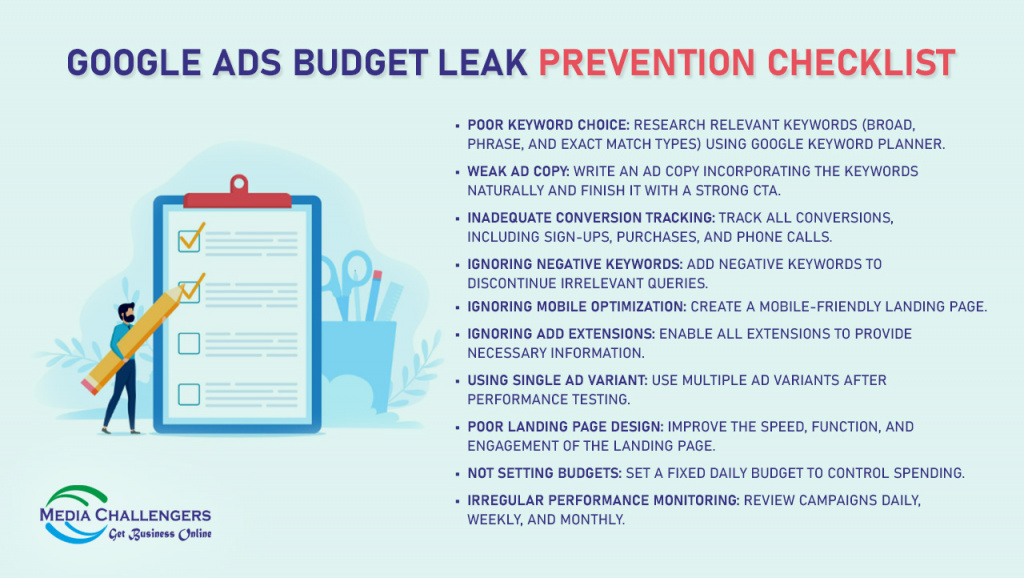
Google Ads Budget Leak Prevention Checklist
- Poor Keyword Choice: Research relevant keywords (broad, phrase, and exact match types) using Google Keyword Planner.
- Weak Ad Copy: Write an ad copy incorporating the keywords naturally and finish it with a strong CTA.
- Inadequate Conversion Tracking: Track all conversions, including sign-ups, purchases, and phone calls.
- Ignoring Negative Keywords: Add negative keywords to discontinue irrelevant queries.
- Ignoring Mobile Optimization: Create a mobile-friendly landing page.
- Ignoring Add Extensions: Enable all extensions to provide necessary information.
- Using Single Ad Variant: Use multiple ad variants after performance testing.
- Poor Landing Page Design: Improve the speed, function, and engagement of the landing page.
- Not Setting Budgets: Set a fixed daily budget to control spending.
- Irregular Performance Monitoring: Review campaigns daily, weekly, and monthly.
Red Flags to Watch For
- Low conversion despite high clicks: Irrelevant keywords in ad settings.
- Low click-through rate (CTR) despite high impressions: Poor ad content.
- No conversions in Google: Conversion tracking disabled.
- Low-intent clicks: Not using negative keywords.
- Low CTR from mobiles: Landing page not optimized for mobile platforms.
- Low quality ads: Necessary extensions disabled.
- Non-performing ads: Not testing ad variants.
- High bounce rate: Low-quality landing page.
- Higher CPC draining budget: No budget assigned to ads.
- Unexplained spike in results: Not monitoring performance.
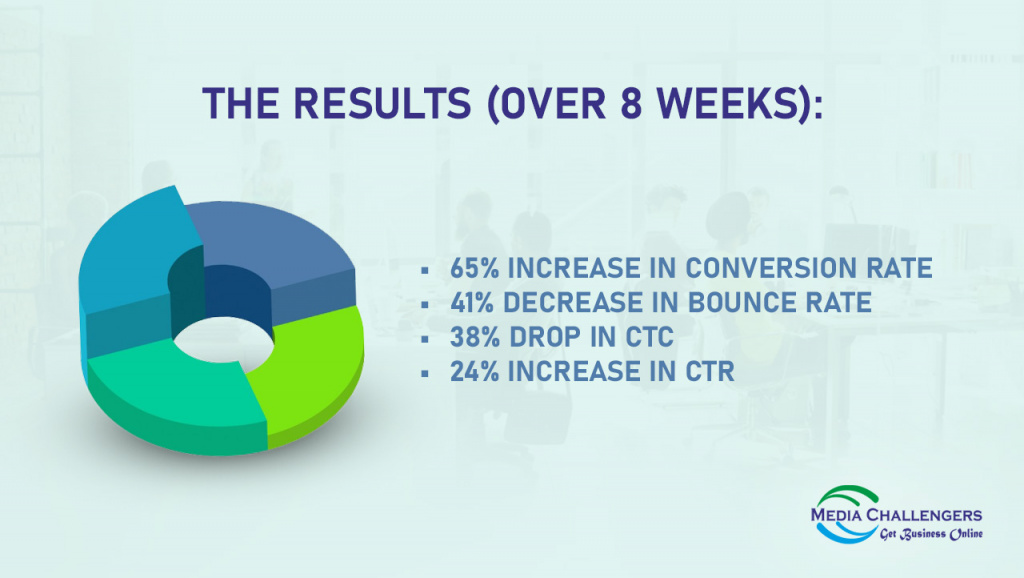
Case Study
Client: A mid-size dental clinic
Problem: The dentist was dissatisfied with the poor performance of Google Ads, despite spending a substantial amount on ads. The conversion rate was low, the cost per click was high, and the traffic quality was poor.
Initial Issues Identified:
1. No Negative Keywords: Their broad match keyword “dentist near me” triggered ads for irrelevant searches like “free dental care” and “dental assistant jobs”.
2. Using One Ad Version: The dentist was using a single version for all ad groups, and that ad copy hadn’t been updated for months.
3. Poor Landing Page Experience: The landing page wasn’t mobile-friendly. The missing call-to-action button further irritated the visitors.
What We Did:
1. Added Negative Keywords: A quick review of the search term report was sufficient to identify the triggers. We added a set of negative keywords, including free, DIY, and jobs, to improve results.
2. Launched A/B Testing: We tested various headlines and CTAs, such as “emergency dentist” with city name, and updated each ad group with multiple tested ad variants.
3. Landing Page Optimization: A new landing page with a clear CTA and simple navigation is created and optimized for mobile platforms.
The Results (Over 8 Weeks):
- 65% Increase in Conversion Rate
- 41% Decrease in Bounce Rate
- 38% Drop in CTC
- 24% Increase in CTR
Conclusion
We noticed that incorporating negative keywords, experimenting with multiple ad formats, and enhancing landing page design gave good results for the client’s Google Ads. The changes brought exciting results, encouraging the client to invest more funds in Google Ads.
Call-to-Action (CTA)
Want to ensure efficiency and profitability in Google Ads? Hire a Google Ads consultant to avoid the common mistakes. A consultant can help you to improve your Google Ads performance.
Book a free Google Ads audit if you need our help. An experienced Google Ads manager will connect with you and present a detailed audit of your ad campaigns. Soon we’ll suggest a winning strategy for your Good Ads campaigns. We assure you of expected results within a short time.
Media Challengers, led by Birendra Kumar, is the foremost SEO and PPC services company, specializing in implementing a comprehensive range of online marketing techniques to enhance business profitability. As a Google certified agency partner, we bring expertise in SEO (Search Engine Optimization) and PPC (Pay-Per-Click) strategies to drive successful digital campaigns.
Do you want an instant result and traffic?
You are at the right place, we are committed for instant result (Call, Query Form, Traffic, view, etc..) generation. If you have any questions please let me know.
Our last month campaign performance

Recent Posts
- How Much Does Google Ads Really Cost for the US market? (2025 Budget Guide) September 25, 2025
- Google Ads Not Working? Get a Free PPC Audit from Our Experts September 7, 2025
- Top 10 Google Ads Mistakes That Waste Your Budget (And How to Fix Them) August 11, 2025

